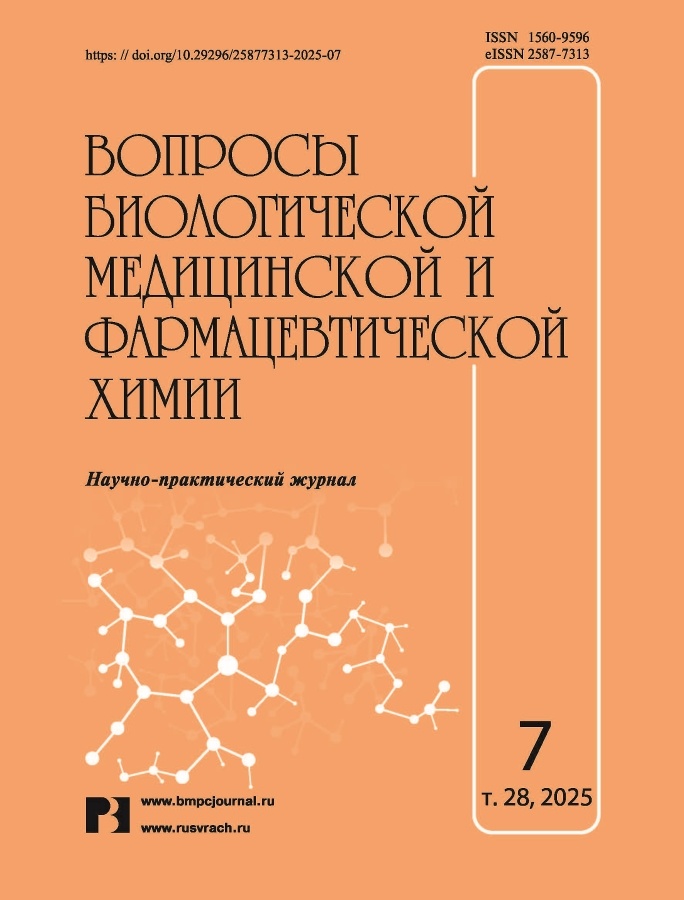Validation of the methods of quantitative analysis of ascorbic acid and rutoside in chewing lozenges
- Authors: Ismailov P.A.1, Inkin A.D.1, Krishtanova N.A.1, Sakanyan E.I.2
-
Affiliations:
- Saint Petersburg State Chemical Pharmaceutical University
- Microgen
- Issue: Vol 28, No 7 (2025)
- Pages: 32-42
- Section: Articles
- URL: https://journals.eco-vector.com/1560-9596/article/view/687952
- DOI: https://doi.org/10.29296/25877313-2025-07-04
- ID: 687952
Cite item
Abstract
Introduction. Chewable lozenges are a relatively new dosage form with advantages such as ease of use, high bioavailability of active ingredients and the ability to control dosage. The development of new compositions with vitamins and vitamin-like substances is an urgent task, for which it is necessary to have validated methods for analyzing their quality. For the composition of lozenges with ascorbic acid and rutoside, titrimetric methods and spectrophotometry have been proposed.
The purpose of the work is to validate methods for the quantitative determination of ascorbic acid and rutoside in chewable lozenges intended for use as therapeutic and preventive vitamin products.
Material and methods. The developed methods for the quantitative determination of ascorbic acid and rutoside in chewing lozenges were validated according to the following indicators: specificity, linearity, analytical range, accuracy and precision (repeatability and intra-laboratory precision) in accordance with the requirements of the GPM.1.1.0012 "Validation of analytical methods" of the State Pharmacopoeia of the Russian Federation XV edition.
Results. Based on the conducted validation, it was confirmed that all applied methods meet the necessary acceptance criteria, which guarantees the reliability and accuracy of the results of quantitative determination of ascorbic acid and rutoside in chewable lozenges.
Conclusions. As a result of the conducted research, it was found that the spectrophotometric determination of rutoside in chewing lozenges is optimally carried out at a wavelength of 360 nm; ascorbic acid by iodometry (basic) and iodometry (alternative). The obtained data will be used in the development of regulatory documentation for the vitamin product.
Keywords
Full Text
About the authors
P. A. Ismailov
Saint Petersburg State Chemical Pharmaceutical University
Author for correspondence.
Email: pasha.ismajlov@spcpu.ru
ORCID iD: 0009-0000-3981-9732
Student, Department of Pharmaceutical Chemistry
Russian Federation, 14 Professor Popova Street, lit. A, Aptekarsky Ostrov Municipal District, St. Petersburg, 197022A. D. Inkin
Saint Petersburg State Chemical Pharmaceutical University
Email: aleksandr.inkin@spcpu.ru
ORCID iD: 0009-0006-5166-8379
SPIN-code: 7685-5418
Post-graduate Student, Department of Pharmaceutical Chemistry
Russian Federation, 14 Professor Popova Street, lit. A, Aptekarsky Ostrov Municipal District, St. Petersburg, 197022N. A. Krishtanova
Saint Petersburg State Chemical Pharmaceutical University
Email: nadezhda.krishtanova@pharminnotech.com
ORCID iD: 0000-0002-4761-2077
SPIN-code: 4395-8012
Ph.D. (Pharm.), Associate Professor, Department of Pharmaceutical Chemistry
Russian Federation, 14 Professor Popova Street, lit. A, Aptekarsky Ostrov Municipal District, St. Petersburg, 197022E. I. Sakanyan
Microgen
Email: pasha.ismajlov@spcpu.ru
ORCID iD: 0000-0002-1693-2422
SPIN-code: 8050-4040
Dr.Sc. (Pharm.), Professor, Director of Science
Russian Federation, 10, the 2nd Volkonsky lane, Moscow, 127473References
- Исхакова Р.Р., Тоболкина В.А., Угрюмова Т.А. и др. Анализ востребованности лекарственных препаратов, содержащих витамины, в лечении терапевтических заболеваний. Университетская медицина Урала. 2017; 3(1): 24–27. [Ishakova R.R., Tobolkina V.A., Ugrjumova T.A., et al. Analysis of the demand for medicinal products containing vitamins in the treatment of therapeutic diseases. Universitetskaja medicina Urala. 2017; 3(1): 24–27. (In Russ.)].
- Всероссийский центр изучения общественного мнения. https://wciom.ru/. Дата обращения: 14.12.2024. [Russia Public Opinion Research Center. https://wciom.ru/. Date of application: 14.12.2024. (In Russ.)].
- Cook J., Sapia M., Walker C. et al. Dysphagia Prevalence in Brazil, UK, China, and Indonesia and Dysphagic Patient Preferences. Healthcare. 2024; 12(18): 1–11. doi: 10.3390/healthcare12181827
- Adkins C., Takakura W., MR Spiegel B. et al. Prevalence and Characteristics of Dysphagia Based on a Population-Based Survey. Clinical Gastroenterology and Hepatology. 2019; 18(9): 1970–1979. doi: 10.1016/j.cgh.2019.10.029
- Rodríguez-Pombo L., Awad A., Basit A. et al. Innovations in Chewable Formulations: The Novelty and Applications of 3D Printing in Drug Product Design. Pharmaceutics. 2022; 14(8): 1–36. doi: 10.3390/pharmaceutics14081732.
- Hattrem M.N., Dille M.J., Seternes T. et al. The Relative Bioavailability of Ibuprofen After Administration with a Novel Soft Chewable Drug Formulation. Clin Pharmacol Drug Dev. 2018; 7(2): 168–176. doi: 10.1002/cpdd.357.
- Krämer J., Gajendran J., Guillot A. et al. Chewable Oral Drug Products. In vitro Drug Release Testing of Special Dosage Forms 2019; 2: 27–53. doi: 10.1002/9781118675748.ch2.
- Amina A., Fatma A. Role of analytical chemistry for the determination of ascorbic acid: a review. Plant Archives. 2020; 20(2): 9067–9072.
- Costinela G., Cristian G., Doina V. et al. Iodometric Quantitative Analysis Method of Ascorbic Acid in Tablets. Revista de Chimie. 2019; 70(10): 3555–3560.
- Kukhtenko H., Bevz N., Kukhtenko O. et al. Spectrophotometric and Chromatographic Assessment of Total Flavonoids Content in Rhodendron Tomentosum Extracts. doi: 10.20944/preprints202312.1212.v1.
- Swann R.V. The spectrophotometric determination of rutin and quercetin in mixtures. J Pharm Pharmacol. 1949; 1(5): 323–329. doi: 10.1111/j.2042-7158.1949.tb12420.x.
- Abualhasan M., Mansour J., Zaid A. et al. Formulation and Development of a Validated UV-Spectrophotometric Analytical Method of Rutin Tablet. International Scholarly Research Notices. 2017; 35: 1–7. doi: 10.1155/2017/2624947.
- Государственная фармакопея Российской Федерации XV издания. https://pharmacopoeia.regmed.ru/pharmacopoeia/izda-nie-15/. Дата обращения: 15.12.2024. [The State Pharmacopoeia of the Russian Federation XV edition. https://pharmacopo-eia.reg-med.ru/pharmacopoeia/izdanie-15/. Date of application: 15.12.2024. (In Russ.)].
Supplementary files










